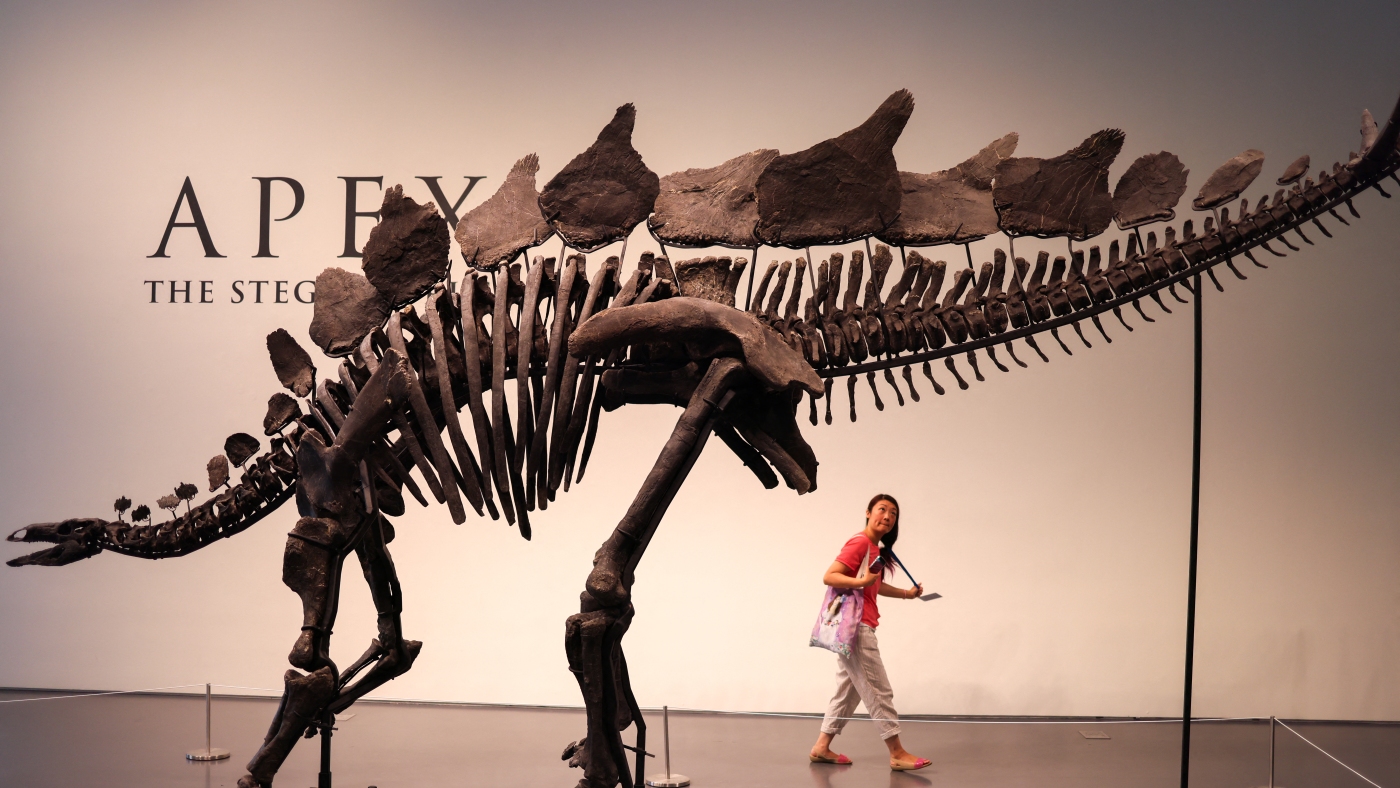
A 150 million-year-old fossil of a stegosaurus specimen is shown at Sotheby’s in New York. The fossil, dubbed “Apex” by the paleontologist who discovered it, is expected to fetch $4 million to $6 million at auction, making it one of the most expensive fossils ever sold.
Charly Triballeau/AFP via Getty Images
hide caption
toggle caption
Charly Triballeau/AFP via Getty Images
During the Jurassic period, a massive, four-legged creature with kite-shaped plates along its back once roamed the Earth. Now, some 150 million years later, the skeletal remains of one of them are up for auction.
On Wednesday, Sotheby’s will hold a live auction of the stegosaurus fossil known as “Apex.” The auction house expects the specimen to sell for $4 million to $6 million, making it one of the most expensive fossils ever sold.

At 11 feet tall and 27 feet long, Apex is also considered one of the most complete skeletal structures of its kind. Paleontologist Cary Woodruff was among the scientists who viewed the specimen at the dig site in Colorado where it was discovered.
NPR’s Andrew Mambo talked with Woodruff, who is also a curator at the Phillip and Patricia Frost Museum of Science in Miami.

The “scutes” or bony plates on a 150 million-year-old stegosaurus fossil’s back at Sotheby’s in New York.
Charly Triballeau/AFP via Getty Images
hide caption
toggle caption
Charly Triballeau/AFP via Getty Images
This interview has been edited for clarity and length.
Cary Woodruff: The first time I saw the specimen, I was with the individual who had collected it out at the quarry where it was found in Colorado. And the rock was incredibly hard. So, it never is like Jurassic Park, but it wasn’t like some beautiful laid out skeleton and oh my gosh you could see the whole thing clear as day. But at least I remember, you know, peering. There’s part of a stegosaurus here. And again, even for any fossil it’s really kind of magical to see this almost like an ugly duckling, too, for any fossil to see it from this preparation process to the end result. You know, it’s always very special for a scientist.
Andrew Mambo: So Sotheby’s is auctioning off this stegosaurus fossil on July 17. The auction house estimates it’ll go for somewhere between $4 million and $6 million. How do they put a monetary value on something like a dinosaur fossil?
Woodruff: Speaking as a scientist, fossils have no monetary value. You know, these numbers are largely arbitrary. I mean, every fossil literally is unique. And I’m not just saying that, as the starry-eyed scientist. Like, there are no two of the exact same animals. I don’t think fossils should be allowed to be auctioned. And these auctions really continue to deepen the divide between what we would consider academic and commercial paleontology.
Mambo: I have read about people also donating and having replicas and not having the exact fossil itself. Can you talk a bit about that? Is that a viable way forward?
Woodruff: I think replicas are the best way possible. I mean, how many of us have a copy of a painting at our home or something? You know the real ones that you can see in a museum? And if some wealthy person is adamant they want to buy this dinosaur being auctioned, that they were adamant they wanted to get this specimen and scientifically see it succeed, and they wanted to donate it to, in this example, a museum, we’ll have a cast that we’ll put up in your living room. Then you can literally showcase it and brag to all your friends and say, “Go to the museum and see the real one, and I was able to put it in that museum.”

The skull of the stegosaurus specimen is shown at Sotheby’s.
Charly Triballeau/AFP via Getty Images
hide caption
toggle caption
Charly Triballeau/AFP via Getty Images
NPR reached out to Sotheby’s Senior Vice President and Global Head of Science and Pop Culture Cassandra Hatton to respond to criticism of auctions of fossil specimens.
“Losing scientifically important fossils to a private collection is a concern often mentioned, but in our experience, we have yet to see it materialize,” Hatton said. “We find that clients overwhelmingly purchase specimens either for museums or donate them.”

